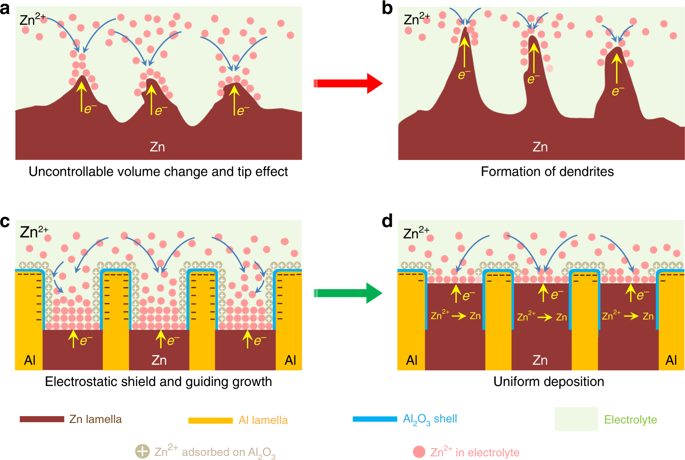Nature Communications ( IF 16.6 ) Pub Date : 2020-04-02 , DOI: 10.1038/s41467-020-15478-4 Sheng-Bo Wang , Qing Ran , Rui-Qi Yao , Hang Shi , Zi Wen , Ming Zhao , Xing-You Lang , Qing Jiang

|
Metallic zinc is an attractive anode material for aqueous rechargeable batteries because of its high theoretical capacity and low cost. However, state-of-the-art zinc anodes suffer from low coulombic efficiency and severe dendrite growth during stripping/plating processes, hampering their practical applications. Here we show that eutectic-composition alloying of zinc and aluminum as an effective strategy substantially tackles these irreversibility issues by making use of their lamellar structure, composed of alternating zinc and aluminum nanolamellas. The lamellar nanostructure not only promotes zinc stripping from precursor eutectic Zn88Al12 (at%) alloys, but produces core/shell aluminum/aluminum sesquioxide interlamellar nanopatterns in situ to in turn guide subsequent growth of zinc, enabling dendrite-free zinc stripping/plating for more than 2000 h in oxygen-absent aqueous electrolyte. These outstanding electrochemical properties enlist zinc-ion batteries constructed with Zn88Al12 alloy anode and KxMnO2 cathode to deliver high-density energy at high levels of electrical power and retain 100% capacity after 200 hours.
中文翻译:

薄层纳米结构的共晶锌铝合金是可逆和无枝晶的水性充电电池阳极
金属锌由于其高理论容量和低成本而成为用于水性可充电电池的有吸引力的阳极材料。但是,最先进的锌阳极在剥离/电镀过程中具有低的库仑效率和严重的枝晶生长,从而妨碍了其实际应用。在这里,我们表明,锌和铝的共晶组成合金作为一种有效策略,通过利用由交替的锌和铝纳米薄片组成的层状结构,基本上解决了这些不可逆性问题。层状纳米结构不仅促进锌从前体共晶Zn 88 Al 12的剥离(at%)合金,但原位产生核/壳铝/三氧化二铝层间纳米图案,进而引导锌的后续生长,从而在无氧的水性电解质中进行超过2000小时的无枝晶锌剥离/镀覆。这些出色的电化学性能使锌离子电池由Zn 88 Al 12合金阳极和K x MnO 2阴极构成,可在高水平电功率下传递高密度能量,并在200小时后保持100%的容量。



























 京公网安备 11010802027423号
京公网安备 11010802027423号